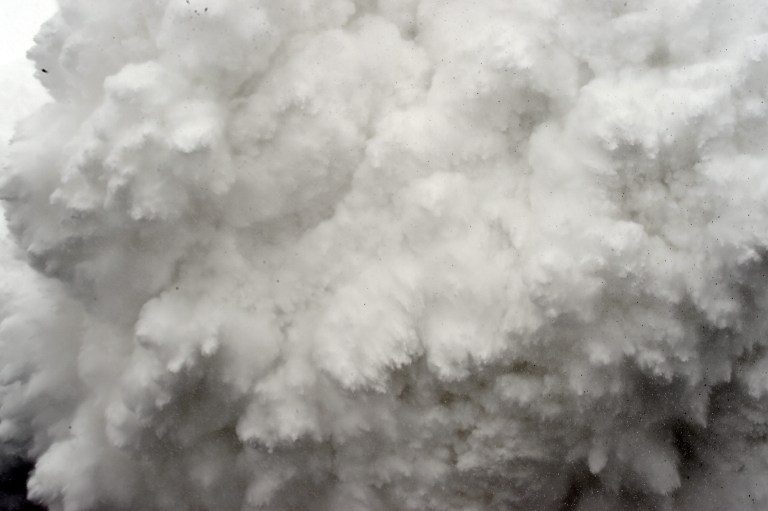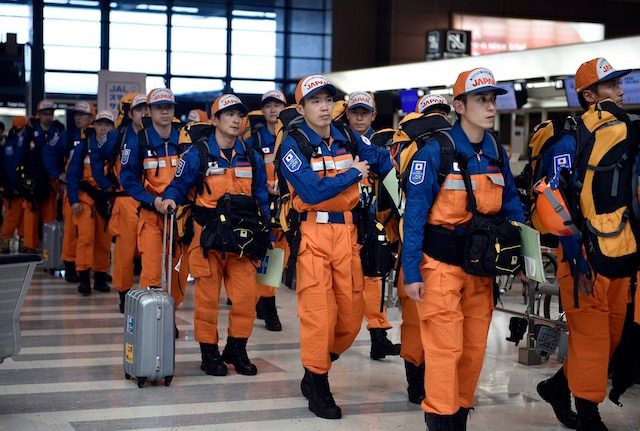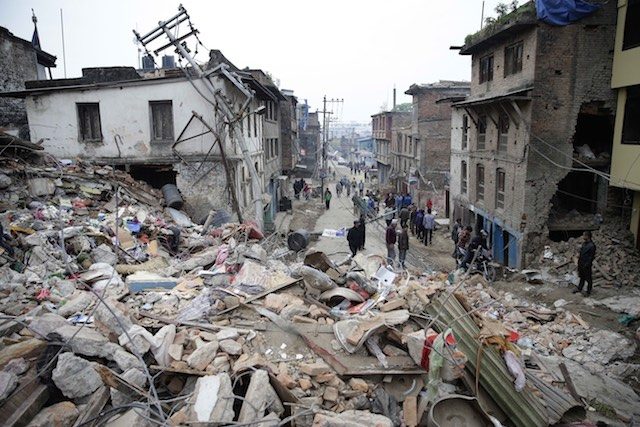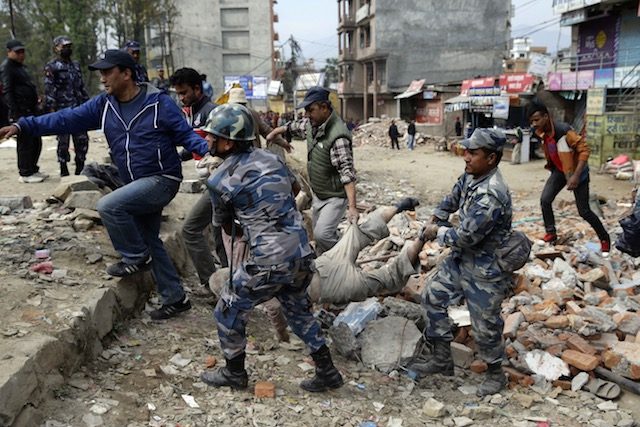SUMMARY
This is AI generated summarization, which may have errors. For context, always refer to the full article.

KATHMANDU, Nepal (3rd UPDATE) – Powerful aftershocks rocked Nepal Sunday, April 26, panicking survivors of a quake that killed more than 2,400 and triggering fresh avalanches at Everest base camp, as rescuers dug through rubble in the devastated capital Kathmandu.
Terrified residents, many forced to camp out in the capital after Saturday’s (April 25) quake reduced buildings to rubble, were jolted by a 6.7-magnitude aftershock that compounded the worst disaster to hit the impoverished Himalayan nation in more than 80 years.
At overstretched hospitals, where medics were also treating patients in hastily erected tents, staff were forced to flee from buildings for fear of further collapses.
“Electricity has been cut off, communication systems are congested and hospital are crowded and are running out of room for storing dead bodies,” Oxfam Australia chief executive Helen Szoke told Agence France-Presse.
Climbers reported that the aftershock caused more avalanches at Mount Everest, just after helicopters airlifted to safety those injured when a wall of snow hit base camp on Saturday, killing at least 18 people.
The deadliest disaster in Everest’s history comes almost exactly a year after an avalanche killed 16 sherpa guides, forcing the season to be cancelled, and as around 800 mountaineers were gathered at the start of the new season.
Agence France-Presse’s Nepal bureau chief Ammu Kannampilly, who was on assignment at base camp, reported that 6 helicopters had managed to reach the mountain on Sunday after the weather improved overnight.
A stunning image captured by the agency’s South Asia photo chief Roberto Schmidt showed a massive cloud of snow and debris cascading onto base camp, burying scores of climbers and flattening tents.
“People being stretchered out as choppers land – half a dozen this morning,” Kannampilly said in a text message. “Weather clear, some snowfall.”
Aid pours in

Offers of help poured in from around the world, with the United States and European Union announcing they were sending in disaster response teams.
The Kathmandu-based National Emergency Operation Centre put the toll in Nepal at 2,430 while around 6,000 more people had been injured.
Officials in India said the toll there now stood at 67, while Chinese state media said 18 people had been killed in the Tibet region.
“We have deployed all our resources for search and rescues,” Bam told Agence France-Presse. “Helicopters have been sent to remote areas. We are sifting through the rubble where buildings have collapsed to see if we can find anyone.”
The fresh aftershocks forced Kathmandu airport to close for around an hour as air traffic controllers had to evacuate the tower. Several flights had to be diverted in mid-air.
The country’s cellphone network was working only sporadically, while large parts of the capital were without electricity.
Devastation in Kathmandu

Agence France-Presse correspondents in Kathmandu reported that tremors were felt throughout the night, including one strong aftershock at dawn before the 6.7-magnitude follow-up quake that struck in the afternoon.
“It has been a sleepless night, how can we sleep? It has been shaking all night. We are just praying that this will end and we can return home,” said Nina Shrestha, a 34-year-old banker who spent the night with hundreds of people on open ground in the capital’s Tudhikhel district. (READ: PH diplomats headed to Nepal; Filipino mountaineers safe)
The historic 9-storey Dharahara tower, a major tourist attraction, was among the buildings brought down in Kathmandu Saturday.
Police said around 150 people were thought to have been in the tower at the time of the disaster, based on ticket sales.
“At least 30 dead bodies have been pulled out. We don’t have a number on the rescued but over 20 injured were helped out,” Bishwa Raj Pokharel, a local police official, told Agence France-Presse.
“We haven’t finished our work there, rescue work is still continuing. Right now, we are not in a position to estimate how many might be trapped.”
As rescuers sifted through the huge mounds of rubble in the capital, hospitals were overwhelmed with victims who suffered multiple fractures and trauma.
“We have treated many people since yesterday, the majority children,” said Samir Acharya, a doctor at Nepal’s Annapurna Neurological Hospital.
“Most patients have head injuries or fractures. Two of our patients died, two are critical.”
At the city’s oldest Bir Hospital, an Agence France-Presse correspondent saw grieving relatives trying to swat away flies from around a dozen bodies that had placed on the floor of the morgue after storage space ran out.
The first mass cremations were held at the Pashupatinath district of Kathmandu, with the smoke from the funeral pyres wafting across a swathe of the city.
Samir Acharya, a doctor at Nepal’s Annapurna Neurological Hospital, said medics were working out of a tent set up in a parking lot to cope with the injured, while some patients were too scared to stay in the building.
‘Just flattened me’

Google executive Dan Fredinburg was one of the climbers to have been confirmed as having been killed in the Everest avalanche.
Experienced mountaineers said panic erupted at base camp, which has been “severely damaged”, while one described the avalanche as “huge”.
“We have airlifted 52 from the base camp so far, 35 have been brought to Kathmandu,” said Tulsi Gautam of Nepal’s tourism department which issues permits to climb the world’s highest mountain.
“Those who are able are walking down. Others are being airlifted.”
George Foulsham, a Singapore-based marine biologist, described the moment that the disaster struck.
“I was outside, saw a white 50-storey building of white come at me. I ran and it just flattened me,” he told Agence France-Presse.
“I tried to get up and it flattened me again. I couldn’t breathe, I thought I was dead. When I finally stood up, I couldn’t believe it passed me over and I was almost untouched.
“I saved for years to climb Everest. It feels like the mountain is saying it’s not meant to be climbed for now. Too much of a coincidence to see this twice in two years.”
Nepal and the rest of the Himalayas are particularly prone to earthquakes because of the collision of the Indian and Eurasia plates.
A 6.8 magnitude quake hit eastern Nepal in August 1988 killing 721 people, and a magnitude 8.1 quake killed 10,700 people in Nepal and India in 1934. – Paavan Mathema, with Ammu Kannampily in Mount Everest, AFP / Rappler.com
Add a comment
How does this make you feel?
There are no comments yet. Add your comment to start the conversation.